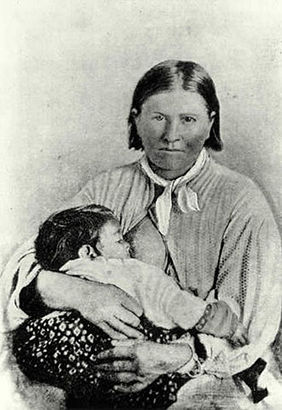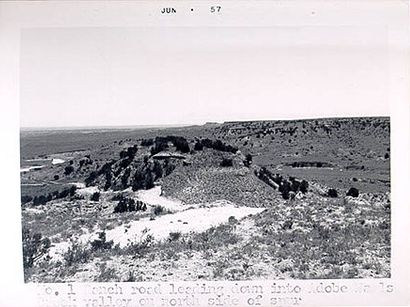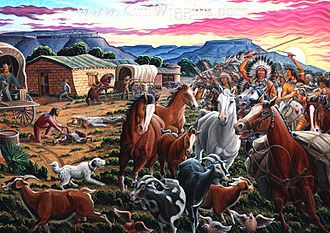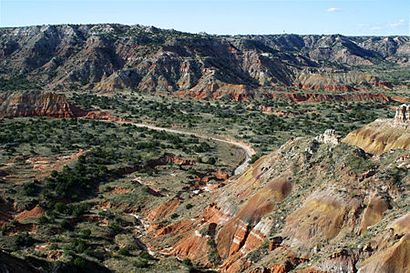|
Books by
Jeffery Robenalt
|
|
|
Quanah
Parker, son of Peta Nocona and Cynthia Ann Parker, was born circa
1847. Although the exact date and place of his birth have been much
debated, by Quanah’s own personal account, he was born in 1845 on
Elk Creek south of the Wichita Mountains in what is now Oklahoma.
Quanah was a major player in both the Comanche war of resistance
against white encroachment of the Comancheria and in the tribe’s
eventual acclimation to reservation life. Nomadic hunter of the
plains, war chief of the Quahadi band, cattle rancher, man of business,
and friend to American presidents; it could truly be said that Quanah
Parker was a man of two worlds. Quanah’s father Peta was a renowned
warrior in his own right and chief of the Noconi band of the Comanches,
and his mother, Cynthia Ann Parker, was the famed captive taken
by the Comanches in an 1836 raid on Parker’s Fort in Parker
County, Texas, when she was only nine. Quanah also had a brother,
Pecos, and a sister, Flower. Together, the group formed a close-knit
and happy Comanche family.
|
|
|
Photo
of Quanah Parker in Pioneer West Museum, Shamrock,
TX
Wikimedia
Commons |
Things came to
an abrupt change in the fall of 1860, when Peta Nocona rode back into
Parker County at
the head of a war party. As the Indians withdrew after their raid,
Sul Ross, a well-known Texas Ranger captain, gathered 70 volunteers
and set out on their trail. Ross also had the assistance of several
Tonkawa scouts and
was later joined by 20 army troopers from the Second Cavalry. Instead
of turning back after a few days of unsuccessful pursuit, which was
the normal course of affairs, Ross decided to keep his men in the
field until they could strike a blow that would teach this particular
band of Comanches a lesson. Pressing deep into the Comancheria, Ross
continued the search until December 17, when Ranger scout Charles
Goodnight and the Tonkawas
located an Indian village on the Pease River. The camp belonged to
Peta Nocona, but the warriors were out hunting and only women, children,
and a few Mexican slaves were present.
Captain Ross led the attack on the village under the cover of a dust
cloud and the noise kicked up by a fierce Texas blue norther, an intense
cold front usually accompanied by gusty winds. In typical Ranger fashion
during a punitive expedition, the fleeing Comanche women and children
were gunned down without mercy. In the middle of the confusion, Ranger
Goodnight
saw the wind tear the blanket away from the face of one of the squaws
and noticed that she had dirty blond hair and blue eyes. “Don’t shoot
her!” Goodnight
yelled. “She’s white!” The blue-eyed squaw was taken prisoner and
Ross agreed that she was Caucasian, although her skin had been darkened
by long exposure to the sun. The white squaw could speak no English
and, she held an eighteen-month-old baby girl in her arms. After fighting
off Peta and the other returning Comanche warriors, Ross carried both
prisoners back to Parker
County by force, where the woman was identified as Cynthia Ann
Parker. Cynthia had to be put under guard to keep her from escaping.
The little girl never adjusted to civilization and died four years
later. In true Comanche fashion, Cynthia Ann scarred her breasts,
prayed to the Indian spirits, and starved herself to death. |
 |
Cynthia Ann
Parker and her child
Wikimedia
Commons |
The raid on the
Comanche camp also resulted in the near extermination of the Noconi
band. Peta and Quanah were forced to take refuge with the Quahadi
Comanches. Peta later died from an infected wound, and Quanah became
an orphan raised by his uncle in the Comanche fashion. Of all the
Comanche bands, only the Quahadis or Antelope people were still powerful.
The other bands, such as the Penateka or Honey Eaters had lived much
closer to the whites and had already been decimated. Quanah soon became
known for his fine horsemanship and eventually turned out to be an
excellent leader. Both qualities proved invaluable when the Quahadis
refused to attend the Medicine Lodge Treaty Council and became a target
of the U. S. Army. Fortunately, the band lived far out on the Llano
Estacado, or Staked Plain, beyond the reach of the army, where they
continued to hunt buffalo
and raid the settlements in the traditional manner. Quanah and his
band of Quahadi Comanches held the Staked Plains virtually uncontested
for the next seven years.
Throughout the years 1871 and 1872, Colonel Ranald S. Mackenzie and
his Fourth U. S. Cavalry scoured the Llano Estacado in search of the
Quahadi. Not only were their efforts unsuccessful, but the cavalry
also fell victim to the Indians at Blanco Canyon on the morning of
October 9, when Quanah and his warriors raided the army campsite and
made off with most of their horses. Mackenzie and his men had a long
walk back to civilization, but instead of holding a celebration for
a hard-won victory, the incident was the beginning of difficult times
for the proud Comanches and other Plains Tribes. If they surrendered
and went to the reservations, they would be fed, but only enough to
barely stay alive. Honesty was certainly not a trait shared by most
Indian agents appointed by the Grant administration. On the other
hand, if the Comanches refused to be penned up and remained on their
beloved Staked Plains hunting buffalo,
they were in danger from Colonel Mackenzie and his cavalry, who had
once again taken up the hunt. |
|
|
Ranald
S. Mackenzie
Wikimedia
Commons |
The real problem
facing Quanah and the Comanches was the disappearance of the buffalo,
the basis of all life for the plains tribes. With the blessing of
the United States Army, the vast herds that once roamed the Great
Plains from Canada to Mexico were being exterminated by the hide hunters
at an alarming rate. Indian hunting parties could ride for days without
sighting a single living buffalo, only swarms of vultures fighting
over the piles meat that were intentionally left to rot. If the plains
tribes were deprived of their primary food source, the Indians would
have no choice but to return to the reservations. Into the middle
of this sinking situation stepped a Comanche prophet named Isa-Tai.
Prophets or messiahs were appearing to various Native American tribes
throughout the West and were a recognizable symptom of the ongoing
social decay of Indian society. Isa-Tai prophesied that the Plains
Indians were doomed if they surrendered to the ways of the whites.
They must instead preserve their native culture and drive the whites
from the plains; only then would the buffalo
return in their former abundance.
In 1874, the Quahadi Comanche, Kiowa, Southern Cheyenne, and the Arapaho
held a council to discuss Isa-Tai and his prophesies. After much negotiation,
Quanah and many other famed war chiefs, who had been enemies for years,
formed an alliance to destroy all the buffalo hunters in Texas as
Isa-Tai had urged. Unfortunately, the coalition could gather only
700 warriors. Of all the tribes that made up the alliance, only the
Quahadi Comanches stood at the zenith of their power. Nothing but
scattered remnants remained from the former glory of their allies.
Quanah Parker was chosen to lead the warriors in battle. Meanwhile,
the hide hunters were ranging further south out onto the Staked Plains
to find buffalo.
The Medicine Lodge Treaty had forbidden this area to the white hunters,
but the army gladly ignored the violation. With the Army’s concurrence,
the hide men established an outpost at Adobe
Walls to carry out the planned extermination of the remainder
of the buffalo.
The small fortified camp became the target for the hatred of the Plains
Indians. |
 |
Adobe Walls
Battlefield
Wikimedia
Commons |
| Early in the
morning of June 27, 1874, well before sunup, Quanah Parker led nearly
700 warriors in an attack on Adobe
Walls. Only twenty-eight men and one woman were present to defend
the camp, and the Indians expected to quickly overrun the sleeping
hide hunters. Unfortunately, the element of surprise was lost when
one of the hunters woke up early to relieve himself and sounded the
alarm. The warriors bravely pressed their attack, but the alerted
defenders were all excellent shots, and every man was armed with a
heavy caliber buffalo rifle. A good number of warriors were unhorsed
during the initial assault, including Quanah, but he was fortunate
enough to scramble to safety behind some low cover. Others were not
so lucky. All around the camp, the accurate long range rifle fire
of the hunters forced the Indians to dismount and take cover. The
Indians were armed with modern repeating rifles, but they were no
match for the distance and accuracy of the hide hunters. After a few
more attempts to overrun the camp had been driven back, the warriors
reluctantly settled into an exchange of long range fire that favored
the defenders. The siege lasted for three days, until the Indians
finally lost heart and departed carrying fifteen dead and many more
wounded. |
 |
|
Painting of
attack on Adobe
Walls
(The Second Battle of Adobe Walls)
Wikimedia
Commons
|
| The angry warriors
soon split up into their own bands and carried death and destruction
across five territories and states, marking the beginning of the widespread
Red River War. Nearby parties of buffalo hunters were caught out in
the open and slaughtered, and the men who had survived Adobe Walls
fled behind the safety of the Texas frontier or back to Kansas. The
attack on Adobe
Walls caused a reversal of United States Indian policy. No longer
would Indian reservations serve as sources of sanctuary. Colonel Mackenzie
and his Fourth Cavalry were again called on to engage the Indians
and “break up their camps.” For nearly a year, Quanah Parker and his
people were constantly harassed and kept on the move, until they reached
the perceived safety of their usual winter camp in Palo Duro Canyon.
The location of the canyon had been unknown to the army, but Mackenzie
forced the information from a Comanchero prisoner. Leaving a company
of cavalry at Tule Canyon to protect his supply train, Mackenzie marched
all night to reach the rim of Palo Duro. Below the rim, a narrow trail
led down to the canyon floor where five sleeping Comanche, Kiowa,
and Cheyenne villages spread out along a winding stream. A huge horse
herd grazed nearer the entrance to the canyon. |
 |
Palo Duro Canyon
Wikimedia
Commons |
| Mackenzie moved
his men to the floor of the canyon as quickly and quietly as possible,
put them on line, and launched the pre-dawn attack by stampeding the
Comanche horse herd. Quanah Parker was up at the crack of the first
shot. Under his direction, the warriors quickly moved in along the
stream and laid down a heavy covering fire, while the women and children
fled from the attacking cavalry. Thanks to Quanah’s leadership all
of the women and children were able to escape, and the warriors who
quickly followed, lost only four men. The women scrambled up the walls
at the rear of the canyon and the warriors helped the children, but
the Indians reached the plain above with nothing. On the surface,
the battle seemed indecisive, but by capturing the horse herd and
burning all five villages along with the large quantities of supplies
that were needed to see the Indians through the winter, Colonel Mackenzie
had struck a deathblow against the Comanches and their allies. Without
a horse, a Plains Indian was lost; he could neither fight nor hunt.
To make matters worse, without their teepees and the store of winter
food, the very survival of the bands was threatened. Under relentless
pressure and suffering from hunger and exposure, Quanah Parker and
the Quahadis reluctantly surrendered and moved to a reservation in
southwestern Oklahoma. |
|
|
Quanah
Parker in business attire
Wikimedia
Commons |
| While some Indians
found it difficult to adjust to reservation life, Quanah Parker adapted
so easily that federal authorities, in an effort to unite the various
Comanche bands, named him chief. Over the next twenty-five years,
the former war chief proved to be a wise, resourceful, and capable
leader in time of peace, lending his support to the construction of
a reservation school and establishing a reservation police force.
Quanah dealt with the unlawful use of Comanche grazing land by cleverly
selling grazing rights to various local cattlemen. The leases not
only raised badly needed cash for the reservation, but now the local
ranchers had an interest in protecting Comanche grazing lands. Quanah
also called on his people to adapt to their new way of life by building
houses in the manner of the whites like his own twenty-two room frame
home called Star House. |
|
|
Quanah
Parker in ceremonial attire circa 1890
Wikimedia
Commons |
|
Through
a series of wise investments, Quanah eventually became one of the
wealthiest Native Americans of his time. He was the close associate
of several prominent Panhandle
ranchers, and a good friend of President Theodore Roosevelt, who
occasionally visited him and accompanied him on hunting trips. His
opinion was also eagerly sought by reporters on a variety of political
and social issues. However, in spite of his dedicated efforts to
adopt white culture, Quanah never completely abandoned his past
or forced his people to totally forsake their traditions, as exemplified
by his founding of the Native American Church movement, his seven
wives and numerous children, and his refusal to cut his long braids.
Sadly, the old war chief took sick with an undiagnosed illness while
visiting the Cheyenne Reservation in early February, 1911, and died
at his home on February 23. Quanah Parker was buried in full Comanche
regalia alongside his mother in Post Oak Mission Cemetery near Cache,
Oklahoma.
© Jeffery
Robenalt
jeffrobenalt@yahoo.com
"A Glimpse of Texas Past"
April 1, 2014 Column
Sources for "Quanah Parker"
›
|
Sources for
"Quanah Parker"
|
|
Exley, Jo
Ella Powell, Frontier Blood: The Saga of the Parker Family,
(College Station, Texas A&M University Press, 2001).
Fehrenbach,
T. R., Comanches: The Destruction of a People, (New York:
Knopf Publishing, 1974).
Gwynne, S.
C., Empire of the Summer Moon, (New York: Scribner Publishing,
2010).
Hamalainen,
Pekka, Comanche Empire, (New Haven: Yale University Press,
2008).
Hosmer, Brian
C., “PARKER, QUANAH,” Handbook of Texas Online, (http://www.tshaonline.org/handbook/online/articles/fpa28),
accessed January 28, 2014. Published by the Texas State Historical
Association.
Jackson, Clyde
L. and Grace, Quanah Parker, (New York: Exposition Press,
1963).
Newcomb, William
W., The Indians of Texas, (Austin: University of Texas Press,
1961).
Weems, John
Edward, The Last of the Indian Wars, (New York: Double Day
Publishing, 1976).
|
|
|
